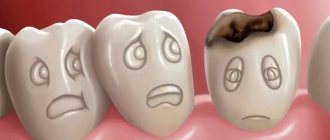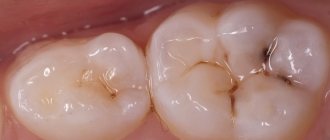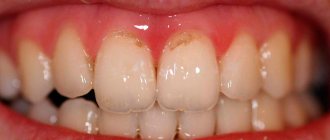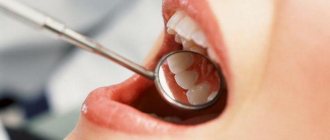Main reasons
Why can one or more teeth turn blue? There may be several reasons for this; sometimes there is nothing dangerous to health in this process, and sometimes this is a reason to urgently seek advice from a dentist. A change in shade is possible due to poor quality nutrition or adherence to a strict diet. This can also happen if you eat a lot of fresh berries, such as blueberries, blueberries or blackberries.
Newly installed fillings may differ in color from natural tissues. A pulpless, that is, dead tooth can also change its color. This is explained by the fact that when the pulp is removed, nutrients stop flowing to the tissues.
If a seemingly healthy tooth begins to turn blue, this may indicate that there are problems with the root system. This is usually preceded by serious dental diseases. In addition, the cause of blue enamel may lie in the patient’s body; this phenomenon may be caused by the presence of chronic diseases or problems with the digestive system. Another common reason is the use of low-quality water with high levels of iron.
How to prevent the problem
High-quality care and systematic teeth cleaning are two basic rules, the observance of which will, to a certain extent, protect oneself from inflammatory and carious processes. In addition, do not forget that every time after eating you need to thoroughly rinse your mouth and use dental floss. It is also important to choose the right toothpaste and brush, especially if you have sensitive gums. And of course, don’t forget to visit the dentist regularly.
If a bluish spot appears on your gum, do not put off your visit to the dentist. The longer you ignore the problem, the higher the likelihood of developing truly serious complications.
- Balakhnichev, D.N. The influence of fixed orthopedic structures on the periodontium of abutment teeth, 2011.
Treatment of blue teeth
If during diagnostics it is determined that the cause of blueness of all teeth is the use of special products, the dentist or hygienist may prescribe a professional cleaning of the oral cavity. Quite often the patient requires enamel polishing; this allows for the best results.
If after such manipulations the blue discoloration does not disappear, you can try other methods.
First of all, the doctor should send the person for an X-ray examination of the jaw, this will make it possible to make a correct diagnosis, as a result of which the treatment will be as effective as possible. It may also be necessary to remove previously installed fillings and caries-infected hard tissues. If necessary, treatment of the annals and root system of the tooth will be prescribed.
There are several methods to restore the original whiteness of your teeth. One of the most common options is the installation of a composite filling, that is, direct artistic restoration of a row. A more expensive procedure is the production of an artificial crown or special onlays - veneers (indirect restoration).
The tooth darkened after treatment, why?
Some patients notice that after treatment, teeth lose color and become darker than neighboring teeth. With what it can be connected?
First of all, modern treatment methods do not imply any change in tooth color after treatment. This has sometimes happened before for many reasons.
If the tooth is alive, the filling on it may darken. Then the problem is either the filling material or the patient’s failure to comply with the doctor’s recommendations. For example, the patient immediately after treatment ate or drank something containing strong dyes. This happens extremely rarely, but it does happen.
Much more often, teeth darkened during root canal treatment. If the canal was not completely cleaned and there was an infection, blood residue or something else in it, then after treatment the tooth could be painted in different colors.
If materials containing resorcinol-formalin were used when filling the canal, the teeth could be stained reddish. Since for a long time teeth were filled with such pastes only in the USSR, a special name for such teeth even appeared in international practice - “red Russian teeth”.
At one time, people managed to fill teeth with pastes containing silver or with silver pins. And very soon they realized that they couldn’t do that. Silver oxidizes over time, producing black oxides, and this inevitably leads to the tooth turning black.
But the most disgusting thing is that not only the tooth can turn black, but also the gums in the area of the root of this tooth. There is also a special name for this - “silver gum tattoo.” This gum remained black forever. Even tooth extraction does not help restore the color of the tattooed gum, and the only treatment option is surgical tissue transplantation.
Therefore, modern dentistry categorically does not recommend filling tooth canals with anything other than gutta-percha. It does not stain tooth tissue, lasts a long time and, if necessary, allows you to refill the canal without any problems.
If the canals are filled with different cements, they sometimes become so hardened inside the tooth that it is not possible to open the canal and go through it again.
The metal from the crowns can also stain the tooth. Sometimes the alloys of the metal frame of the crowns also contain substances that stain the tooth and gum tissues, and then bluish-grayish rims appear around the crowns over time, which are then very difficult to remove and disguise with new crowns.
Therefore, today it is considered the best to use crowns based on zirconium dioxide. It does not oxidize, is white in color and does not change color throughout its service life.
Blue gums
Another common phenomenon, especially in young children, is blue discoloration of the gum tissue. It often occurs during the eruption of the first, baby teeth. During this process, inevitable damage occurs to tissues penetrated by a huge number of blood vessels of different sizes. As a result, blood can enter the soft tissue, leading to the formation of a small hematoma.
That is why, if a baby has a hematoma or bruise in a place where a new tooth is expected to appear soon, there is no cause for concern. However, in all other cases it is recommended to show the child to the dentist. The cause of blueness may be an inflammatory process. It is usually preceded by diseases such as gingivitis or stomatitis.
It is important that such complications usually occur in children with weakened immune systems. Also, the health of teeth and gums is greatly influenced by compliance with the rules of daily care. Due to the abundant accumulation of plaque and stone, most ailments appear; this is especially dangerous at an early age, when the enamel is not yet strong enough.
What can you do as an emergency?
It was already mentioned above that the most common cause of symptoms in childhood is the process of teething or changing teeth. To help your baby endure this difficult and painful period more easily, special ointments and gels with an anesthetic effect will help: “Kalgel” or, for example, “Cholisal”. As a rule, such a problem does not require medical intervention - the process of “punching” the tooth out usually takes several days. To speed up this process, you can resort to the help of special baby teethers. The blue spots will gradually resolve on their own.
If the cause of the blue discoloration is a growing tooth, then the symptoms may resolve on their own
As for other causes of hematoma, including in adults, you cannot do without the help of a doctor. During a visual examination and examination of the clinical picture as a whole, the specialist will determine whether the symptom is a consequence of a disease of the oral tissues, a pathology of the body, or an incorrectly fixed crown. Only after this the doctor will be able to begin treatment. If the problem is gingivitis or stomatitis, then the patient will be prescribed a course of appropriate anti-inflammatory and antibacterial drugs - both for oral administration and for external treatment of the affected areas.
If the problem is the result of an incorrectly installed crown or prosthesis, you will have to completely remove the orthopedic device and undergo anti-inflammatory therapy. The prosthetic device is sent for correction or completely replaced with a new design, which is certainly the best option. When a bruise becomes the result of mistakes made by the doctor during filling, a temporary filling is applied and a course of anti-inflammatory drugs is also prescribed.
Associated symptoms
Gums can turn blue not only in the youngest patients, but also in adults. As a rule, this pathology is accompanied by many other symptoms. Most often, a person experiences noticeable pain, especially with accidental contact with tissue or with solid food, and the gums may swell and bleed.
If the cause of darkening or the appearance of age spots lies in the inflammatory process, the following symptoms can be diagnosed: severe fever and chills, itching and burning, the appearance of blood or purulent discharge, and others. In this case, immediate treatment is required in a dental clinic; traditional methods will not be effective.
If the cause of darkening of the gum or tooth is the incorrect installation of a prosthesis or crown, the patient may complain of pain even at rest, as well as slight tingling and numbness of the tissue (a sensation similar to what happens after the end of anesthesia).
previous post
How is a general examination at the dentist performed?
next entry
What to do if the fabrics turn blue
Beforehand, if blueness of the mucous membrane in the mouth appears, you should consult a specialist. There may be a serious pathology at work. The doctor will conduct the necessary examination and prescribe the correct treatment. Self-diagnosis, and even more so self-medication, can cause harm and complicate the situation.
If the reason for the change in shade is poor-quality prosthetics on implants, then correction of the system, the method of fixing it on the gum, or a complete replacement of the structure will be necessary. Probably, to quickly restore the natural appearance of the tissues, the use of a special ointment will be prescribed. The doctor will also tell you how to care for the prosthesis.
Blueness of the gingival area due to the inflammatory process is treated conservatively. Typically, a medication course includes:
- taking an antibiotic;
- undergoing physiotherapeutic procedures;
- massage.
Blue discoloration caused by the installation of a dental implant on the first or second day after surgery is considered normal. It is mostly associated with the traumatic nature of the process. The recovery period takes place under conditions of regular antiseptic treatment of the oral cavity, so the symptom goes away after a little time. As for the change in shade due to the titanium rod shining through the mucous membrane, the situation cannot be corrected. This can be avoided in the future by selecting implants made of zirconium. Its shade is more natural.
Opinion of an implant surgeon : “Over many years of practice as an implantologist, I have seen many cases of gingival tissue turning blue after the procedure for introducing titanium structures. At the first stage, this is a normal phenomenon associated with a violation of the integrity of the jaw structures. Usually after a few days the color is restored due to the normalization of blood circulation. You shouldn’t worry too much about this, just follow the recommendations given by a specialist.”
Sometimes the pathology may not be related to dental aspects . Then the doctor conducts an examination to find out its causes. For this purpose, specialists from other fields are involved.
Why does sensitivity increase?
In some cases, after installation, Patients complain of a greatly increased sensitivity, causing pain when eating or talking. In most of these cases, pain intensifies two weeks after the restoration procedure. The reason is too much enamel layer removed during preparation. This increases tissue sensitivity and causes an enhanced reaction.
To resolve the issue, the doctor may prescribe the following measures:
- tissue fluoridation procedures are performed within three to five days;
- A varnish is applied to the surface to protect against excessive sensitivity; for better hardening of this composition, it is additionally polymerized with lamp light;
- office cleaning from accumulations of plaque and stone;
- removal of the nerve after hiding the tooth (in the presence of severe pain and ineffectiveness of previously taken measures).
The patient must understand that the installation of veneers with preliminary preparation is an irreversible process. The teeth will no longer return to their previous condition; the enamel is completely removed, which means that the linings will have to be replaced after the end of their service life. The doctor should also explain that increased sensitivity is a normal reaction; only severe, constant pain is considered a complication.
The situation gets worse if the plate is damaged, has chips and signs of deformation. Dentin remains under the overlay without additional protection in the form of an enamel layer, that is, every touch will be painful. In this case, the veneers must be changed; if the pain persists, the nerve is removed.
Operational terms
The service life of the linings depends on the following nuances:
- type of design, materials of manufacture;
- thickness, method of fastening to the surface;
- dental condition;
- Patient compliance with oral care recommendations.
The most durable are ceramic plates. They can withstand significant loads, look natural and do not require frequent replacement. The service life of such plates is eight to ten years; if the rules of care are followed, they can last longer. Zirconium models are stronger and will last a couple of years longer. Composite straight overlays are the most short-lived. On average, correction will be required within five years after installation.
Recommendations for the Patient
After installing the pads, the patient is given recommendations on how to care for them:
- daily cleaning using non-abrasive pastes and brushes with medium or soft bristles;
- the use of irrigators and rinses to remove food debris;
- Regular visits to the dentist for in-office plaque cleaning and preventive examinations.
In addition, loads should be distributed correctly and loads on the frontal zone should be avoided. It is recommended to give up bad habits and change your diet, eliminating coloring foods from it. For those who play sports, it is necessary to use protective mouthguards. Such simple rules will help maintain a healthy smile and the integrity of the installed veneers for a longer period.
Symptoms
When the appearance of the gums changes, patients present the following complaints:
- pain when brushing teeth and chewing food;
- itching in the mouth;
- swelling of the periodontal mucosa;
- bleeding gums;
- the presence of abundant dental plaque and mineralized deposits;
Symptoms of cyanosis of the soft tissues of the oral cavity depend on the cause of the disease, as well as the individual characteristics of the body. Eliminating the cause of blue gums is the first stage of treating the disease and alleviating the patient’s condition.
To treat or not?
What to do if a blue tooth appears? Is there any way to treat the symptom? It all depends on what exactly caused this symptom. To start, try simply using a toothbrush and toothpaste. Thoroughly clean the enamel on all sides and rinse your teeth. After this, evaluate their condition. If the enamel has become lighter, then most likely it is due to nutrition. Review your diet. Eat more dairy products and protein-containing meals.
Why do my gums turn blue?
There are many factors that influence periodontal health. The incidence rate depends on both the age of the patient and his dental status.
Causes of blue gums in a child
Blueness of soft tissues in a child’s mouth can occur for the following reasons:
- Eruption of primary and permanent or permanent teeth.
Due to high mechanical pressure on the blood vessels of the periodontium, a blue hematoma occurs.
- Bruises and cuts.
After falls during active games, multiple hematomas occur. Due to mechanical trauma, a blood clot accumulates at the site of the bruise, as a result of which the gums around the tooth become blue.
Why does an adult's gums turn blue?
The causes of blue gums in an adult can be:
- Disorders of the cardiovascular system, endocrine system, and kidney disease.
- Inflammatory diseases of the oral cavity: gingivitis, periodontitis, herpetic and candidal stomatitis, periodontal disease, accompanied by the deposition of bacterial plaque on the surface of the teeth.
- Caries and its maltings, localized in the cervical area of the tooth.
- Errors in orthodontic treatment.
An incorrectly made denture impairs blood flow in the gingival margin, causing the appearance of a blue tumor. In this case, blue discoloration is a consequence of a violation of the trophism of soft tissues in the oral cavity.
- Surgery.
Blue gum most often occurs after tooth extraction. As a rule, tightening of soft tissues is completed by 10 days after extraction.
- Burns from chemical and thermal irritants.
Chemical burns occur due to exposure of the mucous tissue to aggressive substances used in endodontic treatment. Blue injuries from exposure to high temperatures occur at the household level.











